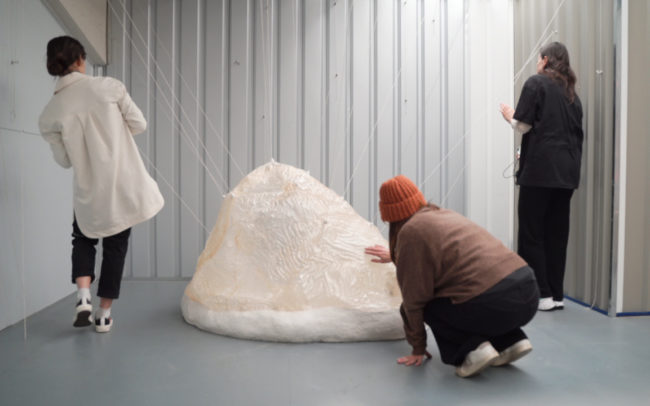Poriferous morphologies of our precarious futures
Pori-morph is a speculative exploration of plausible futures for temporary dwelling spaces. Questioning the form, function, durability, and locality of our housing structures, this experimental project marks only a fraction of ongoing research that reimagines the role human beings play in designing, constructing, and maintaining our built environments.
Institute
Royal College of Art
Student
Claudia Palcova
Supervision
Charlotte Jarvis, Dr. Claude Dutson
Viewing housing structures as extensions of our skin, Pori-morph aims to nurture more instinctive interactions with our personal spaces, blurring the boundaries between our bodies and their surroundings. It imagines morphing structures that can adapt their physical qualities in response to our constantly changing needs. Single membrane structures that can provide support and disruption, protection and exposure, connection and isolation all at the same time.
I drew inspiration from the unity of colonial organisms, the ability of multiple individuals to form symbiotic relationships, in order to create a stronger, safer living environment. Following my studies of bubble corals and their responsive form affected by external and internal conditions, I began to question our building methods as well as our living patterns. How can future dwelling spaces benefit from already built environments? How can temporary dwelling structures grow on top of permanent sites? How can they form a symbiotic relationship? How can they accommodate growth and adaptation? How can they morph around our bodies? How can they merge our bodies with their surroundings?
The entire Pori-morph unit was cooked and constructed at home with limited means, emphasising void as the main tool for manipulation and modification of the structure’s physical qualities. Working with bioplastics in an attempt to create a fully biodegradable structure, I quickly realised that employing void for material manipulation enables me to introduce a variety of forms, textures, flexibilities, thicknesses, and transparencies. It allows me to open up the space or on the other hand create a more intimate space, in turn changing the impact of the void. This approach subsequently reduces our dependency on multiple possessions and instead nurtures a natural connection with our environment.
Throughout my experimentations with biomaterials, I became fascinated by the idea of cooked architectures. Employing non-invasive methods and ingredients that are affordable and accessible to everyone, allows quick and effortless construction of temporary shelters. Pori-morph is my first attempt to create a freely accessible dwelling space that removes all distractions of the city. Acting as a womb, a cocoon, its form is minimal, leaving the focus on its relationship with the body and mind. Its ability to adapt and morph around its occupant. Its ability to allow controlled light transmission and form distortion through material manipulation. Utilising morphing, biodegradable materials reliant on support from permanent sites, this speculative piece emphasises the importance of a symbiotic relationship between the structure, the occupant, and their surroundings.
Institute
Royal College of Art
Student
Claudia Palcova
Supervision
Charlotte Jarvis, Dr. Claude Dutson
Your consent is required to display this content from vimeo - Privacy Settings













